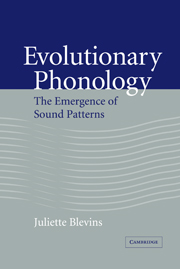8 - Some uncommon sound patterns
Published online by Cambridge University Press: 22 September 2009
Summary
The range of things that are actually attested in natural languages is determined not only by the possibilities made available by the human cognitive-linguistic ability (which linguistic theory attempts to characterize), but also by contingent facts about the world.
Anderson (1992: 63)It would be unsafe for speech communities to depend on performance at the very limits of the physical possibilities of a speaker's vocal apparatus. The relationship between absolute anthropophonic possibilities of speech performance on the one hand, and the phonetic selection by a language of some zone within those possibilities on the other, is not one which places phonetic performance at the very outer perimeter of anthropophonic space, as it were.
Laver (1994: 433)In this chapter, I investigate potential explanations for uncommon sound patterns. For the purposes of this discussion, uncommon sound patterns are those which are limited to a few languages, a few language families, or to a small number of geographic regions.
Certain sound patterns, like many of those summarized in chapters 4-6, are natural and frequent in the world's languages, while others are uncommon or unattested. In contrast to the common pattern of regular word-final obstruent devoicing, regular word-final voicing is unattested, though limited final voicing is found in at least one language, Lezgian, as discussed in 4.7. In chapter 4, the common occurrence of synchronic final devoicing is attributed to common instances of phonetically motivated sound change.
- Type
- Chapter
- Information
- Evolutionary PhonologyThe Emergence of Sound Patterns, pp. 192 - 214Publisher: Cambridge University PressPrint publication year: 2004

